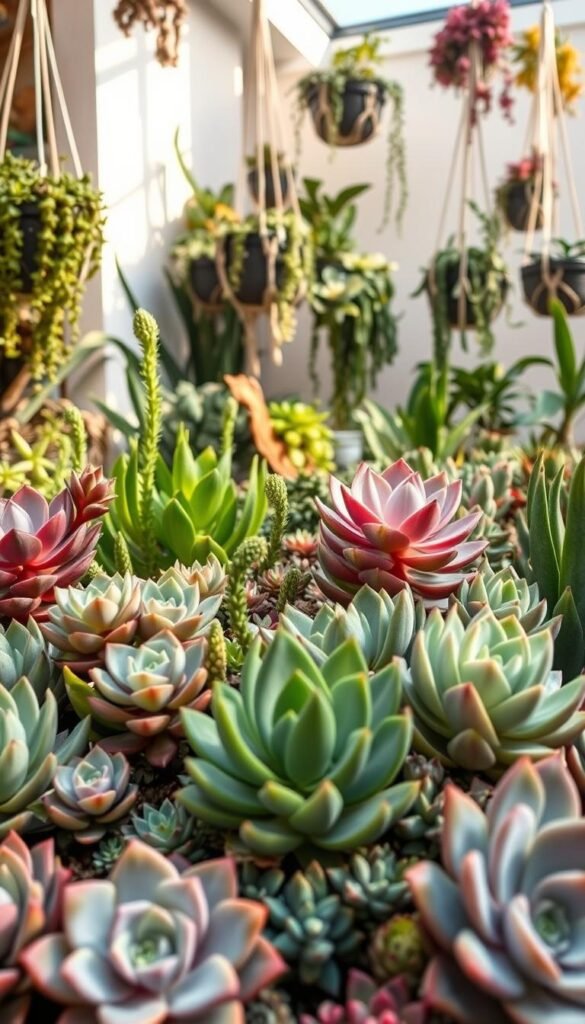Ever wish you could add natural beauty to your home without the hassle? Drought-tolerant varieties offer a simple solution for modern lifestyles. These compact wonders store moisture in their leaves, letting them thrive even when your calendar’s packed.
Plant expert Paris Lalicata, who cares for 200+ specimens at The Sill, explains: “The right light and occasional watering are all most varieties need.” Her decade of experience helps beginners master stress-free plant care while avoiding common pitfalls.
You’ll find tips here for arranging eye-catching displays that match your decor. Discover how to pick species that grow happily in your home’s conditions. We’ll even share clever ways to group different textures and colors for maximum impact.
Best part? You don’t need a green thumb. With proper light and minimal attention, your collection becomes a living work of art. Ready to create an indoor garden that fits your rhythm? Let’s begin.
Discovering the Charm of Indoor Succulent Gardens
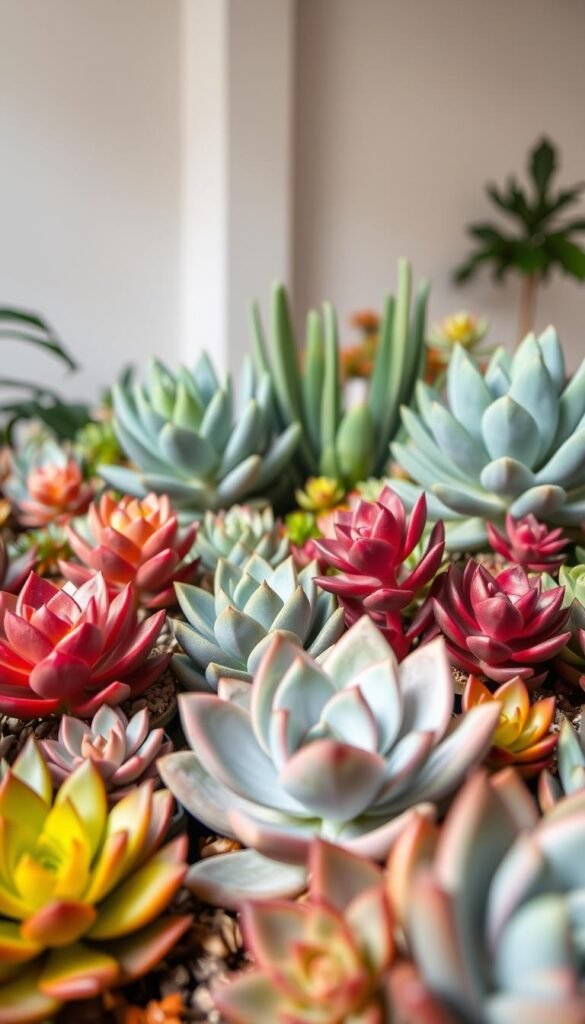
Imagine transforming your living space with greenery that thrives on neglect. These resilient varieties have surged in popularity, especially among professionals craving nature’s touch without rigid routines. Their secret? Built-in water storage systems let them flourish even when life gets chaotic.
Embracing Easy-Care Houseplants
Modern plants work with your lifestyle, not against it. Studies show rooms with living foliage reduce stress by 15% while filtering airborne toxins. You get:
- Natural air purification without gadgets
- Visual calmness in high-traffic areas
- Weekly care routines taking under 10 minutes
Why Indoor Gardening Fits Your Busy Schedule
Forget daily watering marathons. Most varieties only need hydration every 2-3 weeks. A NASA-funded study found certain species remove 87% of toxins in 24 hours – perfect for time-crunched spaces. Your attention stays focused on priorities while these quiet companions handle the growing.
Start with one shelf-friendly specimen. Watch how its steady growth builds your confidence. Soon, you’ll crave more textural varieties to craft living art that mirrors your personal style – all on your terms.
Choosing the Perfect Succulents for Your Space
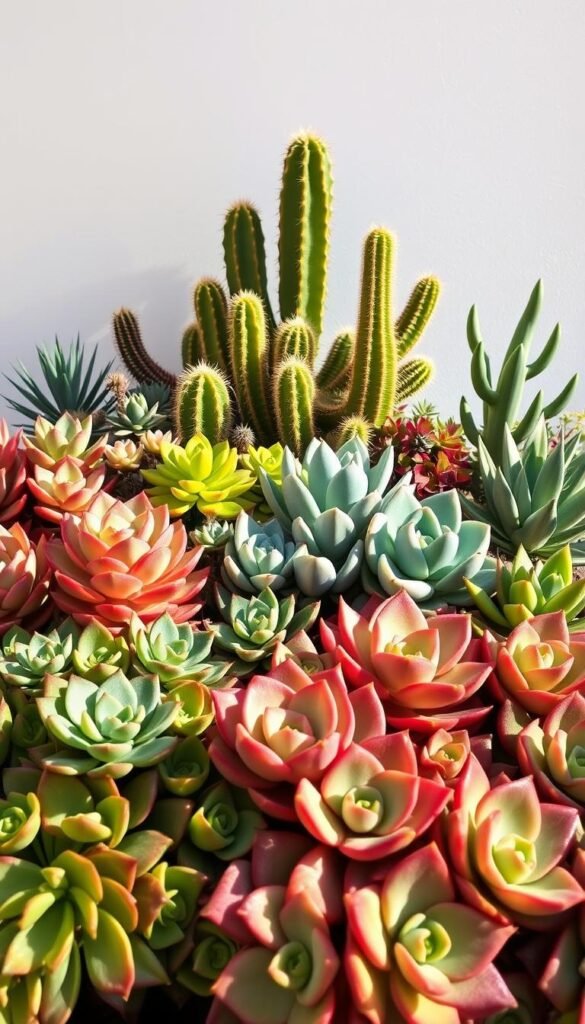
Finding plants that adapt to your lifestyle starts with understanding their survival traits. Resilient varieties share three key features: water-storing capabilities, pest resistance, and flexibility in various light conditions. These qualities let them handle occasional neglect while still adding vibrant energy to your rooms.
Characteristics of Low-Maintenance Houseplants
Look for thick leaves or stems – nature’s built-in water reservoirs. Snake plants thrive in dim corners, while ZZ varieties shrug off irregular watering. Pothos vines flourish in both bright and shaded areas, adapting as your space evolves.
True survivors:
- Endure 3+ weeks without hydration
- Resist common pests naturally
- Grow steadily in fluctuating temperatures
Tips for Selecting Beginner-Friendly Varieties
Match specimens to your existing light patterns. North-facing window? Try snake plants. Sunny sill? Aloe vera loves the spotlight. Start with one hardy plant to learn its rhythms before expanding your collection.
Pro tip from nursery growers: “When unsure, choose thicker-leaved plants – they’re more forgiving of rookie mistakes.” Pair this knowledge with your room’s conditions, and you’ll create a thriving display that grows with your skills.
Understanding Light and Water Needs
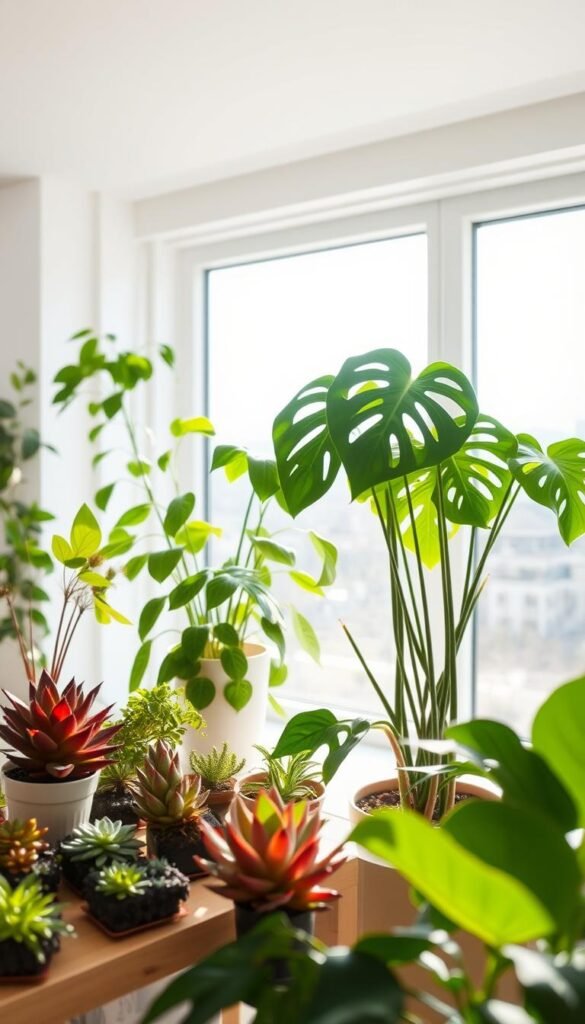
Want your leafy friends to thrive without constant attention? It all comes down to two factors: bright indirect light and smart hydration habits. Nail these, and your collection becomes nearly self-sufficient.
How Bright Indirect Light Benefits Your Plants
Sunlight filtered through curtains or bounced off walls creates the ideal glow for most varieties. Direct rays can scorch leaves, while dim corners stunt growth. Bright indirect light mimics their natural habitats, promoting vibrant colors and steady development.
String of Pearls and Aloe Vera flourish near east-facing windows where morning sun gently bathes their foliage. Use this simple test: Place your hand 12″ from a light source. If the shadow appears soft-edged but defined, you’ve found the sweet spot.
| Plant | Light Needs | Water Frequency |
|---|---|---|
| String of Pearls | Bright indirect | Every 14 days |
| Aloe Vera | Bright indirect | Every 14-21 days |
| Snake Plant | Low to bright indirect | Every 21-28 days |
Watering Practices: Allowing Soil to Dry Out
Overwatering drowns roots faster than neglect. Wait until soil feels completely dry 1-2 inches down – your finger makes the best moisture meter. When you do water, soak thoroughly until it drains from the pot’s base.
Pro tip: Mark watering days on your phone calendar. Most varieties need hydration every 14-21 days, but always check soil first. Your plants will reward this patience with plump, healthy leaves that store water like nature intended.
Succulent Garden Indoor: Easy-Care Houseplants for Busy Schedules
Transform empty corners into vibrant displays with smart setup strategies. The secret to success lies in matching your space to your plant’s natural preferences. Start by choosing containers with drainage holes – terra cotta pots work wonders for moisture control.
Creating a Thriving Setup
Your soil choice matters more than you think. Mix cactus potting medium with perlite for quick drainage. This combo prevents root rot while giving roots room to breathe. Place taller specimens like Money Trees at the back of arrangements – their love for bright indirect light makes them perfect near east-facing windows.
Follow these three steps for foolproof results:
- Map your room’s light patterns using a compass app
- Group plants with similar water needs together
- Use saucers with pebbles to boost humidity naturally
Rotate pots quarterly for even growth, especially for light-loving varieties. Keep a watering can and moisture meter nearby – these tools cut care time in half. For more inspiration, explore our favorite low-maintenance varieties that adapt to any schedule.
Remember: Your indoor garden should work for you. Start small, observe how plants respond, then expand your green oasis one resilient specimen at a time.
Top Picks for Indoor Succulent Enthusiasts
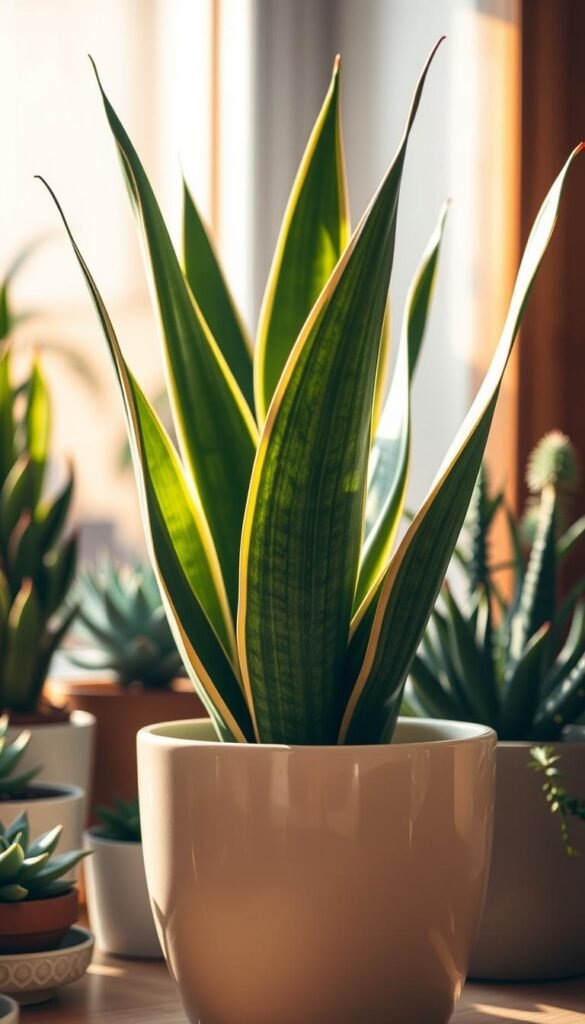
Building your collection starts with reliable performers that adapt to real-life conditions. Meet three champions that combine striking looks with practical care routines. Their secret? Built-in resilience that forgives missed waterings and thrives in varied light conditions.
Featured Favorites: Snake Plant, ZZ Plant, and More
The snake plant stands tall as the ultimate survivor. Its sword-like leaves filter air while needing hydration only every 3-4 weeks. Perfect for dim corners or sunny spots, it grows steadily without fuss.
ZZ plant brings drama with its glossy leaves that shimmer in any light. This drought-tolerant beauty stores water in its roots, thriving even when you travel. Pair it with bright accessories for a modern look that pops.
| Variety | Light Flexibility | Water Schedule |
|---|---|---|
| Snake Plant | Low to Bright Indirect | Every 2-4 weeks |
| ZZ Plant | Low to Bright Indirect | Every 3-4 weeks |
| Golden Pothos | Bright to Low Light | Every 1-2 weeks |
Golden Pothos vines add movement to shelves with heart-shaped leaves. It grows fastest in bright light but tolerates shade better than most plants. Let trails cascade from hanging planters or train them along walls for living art.
Pro tip: Group these varieties based on their water needs. Place thirstier plants near each other for efficient care. Your green oasis stays lush with minimal effort, letting you enjoy nature’s beauty on your terms.
Expert Advice for Low-Maintenance Gardening

What if your plant care routine felt more like a hobby than a chore? Paris Lalicata, who manages 200+ specimens at The Sill, shares wisdom honed through a decade of hands-on experience. Her approach turns nervous newbies into confident caretakers through practical, stress-free methods.
Insights from Proven Plant Pros
Lalicata’s golden rule: “Start small and observe first.” She recommends beginning with one resilient variety to build skills without overwhelm. Her students often see success with snake plants or pothos – species that visibly communicate their needs through leaf changes.
Three game-changing tips from her playbook:
- Water only when soil feels dry 2 inches deep
- Rotate pots monthly for even light exposure
- Use room-temperature water to prevent root shock
“Plants want to survive – your job is simply to listen,” Lalicata notes.
Her methods reduce care time while boosting plant health. Beginners learn to spot early signs of thirst or light starvation, preventing 80% of common issues. This proactive approach builds confidence faster than reacting to crises.
For air-purifying power, she suggests grouping 3-5 plants in high-traffic areas. This creates microclimates that naturally regulate humidity. Your attention stays focused on life’s demands while greenery works its quiet magic.
Creating a Stylish Arrangement for Your Greenery
Your living space becomes a canvas when arranging plants thoughtfully. Three standout varieties offer unique textures: String of Dolphins’ cascading stems resemble leaping marine life, Bird’s Nest Fern’s wavy leaves create tropical vibes, and Philodendron Moonlight’s glowing foliage adds instant drama.
Designing an Aesthetic Display
Balance vertical and horizontal elements using these principles:
- Place trailing varieties like String of Dolphins on high shelves
- Use Bird’s Nest Fern as bold centerpieces
- Position Philodendrons where new growth catches light
This table helps mix shapes and needs effectively:
| Plant | Light Needs | Visual Feature |
|---|---|---|
| String of Dolphins | Bright indirect | Cascading stems |
| Bird’s Nest Fern | Medium indirect | Crinkled leaves |
| Philodendron Moonlight | Low to bright | Color-shifting foliage |
Group specimens in odd numbers for natural appeal. Rotate pots monthly to ensure all sides receive equal light. Your home transforms into a living gallery where greenery enhances both air quality and visual flow.
Troubleshooting Common Indoor Plant Challenges
Your leafy companions might occasionally send distress signals – but decoding them is easier than you think. Peace lilies, for instance, dramatically droop when thirsty, while spider plants tolerate dim corners better than most. The key lies in spotting early warnings before minor issues escalate.
When Too Much Love Hurts: Water and Light Fixes
Soggy soil often causes more harm than drought. Watch for these red flags:
- Yellow leaves that feel mushy at the base
- Stems turning translucent or black
- Musty odor from potting mix
If you spot these signs, stop watering immediately. Let the soil dry completely – some plants recover best when left alone for 2-3 weeks. For chronic overwaterers, switch to pots with drainage holes and fast-draining cactus mix.
Light issues? Use this quick-reference table:
| Symptom | Low Light Fix | Bright Light Fix |
|---|---|---|
| Leggy growth | Move nearer to windows | Filter with sheer curtains |
| Faded colors | Add grow lights | Rotate plants weekly |
Spider plants demonstrate remarkable adaptability, thriving in both low light and bright spaces. If leaves develop brown tips, they’re likely begging for humidity – mist them weekly or use a pebble tray. Remember: Most issues resolve quickly once you adjust care routines. Your plants want to bounce back!
Care Tips for Unique Indoor Foliage and Vines
Elevate your plant parenting game with species that turn heads while forgiving occasional forgetfulness. Philodendron Micans’ velvety leaves shimmer in bronze hues, while String of Pearls drapes like living jewelry. These statement-makers thrive when you master their simple rhythms.
Mastering Resilient Leafy Stars
Snake plants demand almost nothing – water them when soil dry completely (about every 3 weeks). Their upright growth purifies air while fitting narrow spaces. Pair with Philodendron Micans, which prefers:
- Medium indirect light near north-facing windows
- Water when top inch soil feels dry
- Monthly leaf wiping to maintain sheen
Cascading Wonders Made Simple
String of Pearls transforms shelves into green waterfalls when given bright light. Water every 14 days using the “soak and dry” method. For compact charm, try Haworthia on sunny sills:
| Variety | Light Needs | Water Signal |
|---|---|---|
| String of Pearls | Bright indirect | Top inch dry |
| Haworthia | Bright indirect | Soil dry completely |
Rotate trailing plants weekly for even growth. Snip leggy stems to encourage bushier shapes – cuttings root easily in water. Your living space becomes a gallery of textures that thrive on thoughtful neglect.
Bonus Ideas for Expanding Your Indoor Garden
Ready to take your plant collection to the next level? Expand beyond the basics with colorful varieties that bring new energy to your space. These eye-catching options maintain the low-maintenance spirit while adding fresh textures and movements.
Colorful Companions That Adapt Easily
The Bromeliad Vriesea Intenso Orange lights up rooms with its fiery center spike. Give it indirect sunlight and pour water into its central cup weekly. Safe for pets and compact enough for shelves, it’s perfect for adding tropical flair.
Prayer Plants dance through the day – their leaves rise and fall with light changes. Place them where morning sun filters through curtains. Let soil dry slightly between waterings every 14 days, and watch their patterned foliage thrive.
For steamy spaces like bathrooms, try Boston Ferns. They crave medium indirect light and humidity more than frequent care. Mist their fronds weekly or set pots on pebble trays to create spa-like conditions effortlessly.
Mix these charmers with your existing greenery. Their care routines align perfectly with plants that prefer hands-off attention. You’ll create layered displays where colors pop and textures harmonize – all while keeping maintenance simple.

